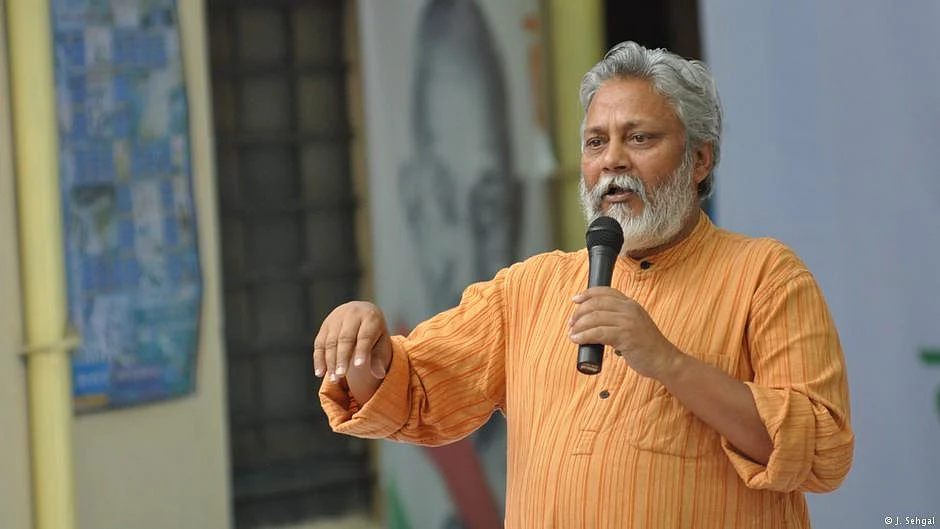How “India’s water man” restores supply in parched north Rajasthan
India is suffering from the worst water crisis ever. But Rajender Singh has been working to restore supply to more than 1,000 villages, and has rejuvenated 11 rivers using traditional techniques

It's early morning in Alwar, Rajasthan, 153 km south of Delhi. Scores of women have gathered at a municipal tap to get water for their families. Each of them has brought numerous vessels to collect as much water as possible, as supply is limited.
India is suffering from the worst water crisis in its history, and millions of livelihoods are under threat according to a recent report by the National Institution for Transforming India, a policy think-tank. The report says that about 2,00,000 Indians die every year due to inadequate access to safe water, with 600 million facing what is termed "extreme water stress."
That stress is evident when the water stops flowing from community water taps such as this one. One person left in exactly that situation was 55-year-old Morchi Bai.
"This is not the first time that the water supply has stopped before my turn has come. Again today, I will have to beg my neighbor for a bucket of water," Bai told DW. "The government needs to look at our problems.”
Running low
India's rural poor are highly susceptible to the effects of extreme weather and climate change. As many as 63 million Indians do not have access to clean drinking water, as reported by WaterAid, a global advocacy group on water and sanitation.
However, there are people battling to bring about change. Rajender Singh, popularly known as the "water man of India," has brought water back to more than a thousand villages, and has rejuvenated 11 rivers which are now flowing year-round as a result of conserving water through earthen bunds—embankments built to hold water in a catchment area.
For his community-based water management efforts, Singh has been granted the Ramon Magsaysay award, and the Stockholm Water Prize—sometimes referred to as the "Nobel Prize for water."
Singh's organisation Tarun Bharat Sangh is located in Bheekampura village, just 64 km from Alwar. But water levels at the two locations are considerably different. Bheekampura is a naturally arid area, but with the lush, green leaves of trees rustling in the breeze, the atmosphere is pleasant; the water stress evident in Alwar is not apparent here. Earthen dams, built by the locals to capture and conserve rainwater, are a common sight.
For 92-year-old Shyoji Ram, the memories of building one such dam alongside his fellow villagers in Bheekampura, under the guidance of Rajender Singh 34 years ago, remain clear. He compares a dark past with a much brighter present.
"There is a massive difference," Ram told DW. "What once was barren land is now filled with water and blooming trees. The river which used to run dry now overflows sometimes." Working with others, Singh blocked monsoon streams and used hills slopes to gather the water. "Rajender's technique has helped the village see water again," Ram said.
Women at the frontlines
Ram is speaking at a so-called water parliament—a community forum where hundreds of farmers have gathered to discuss issues around water. The forum is taking place at Bheekampura, and caters to residents of Alwar and surrounding districts.
At the event, Singh thanks people for their efforts in protecting local water supplies. "A community management system is the best method to deal with natural resources," he said. "We were able to build 11,800 annicuts, check dams, and bunds in the last 34 years. We were also able to restore water to around 2,50,000 wells that had long since run dry."
Addressing the assembly, he explains how "johads," or earthen dams for catching rainwater, can prevent flooding and raise groundwater levels. The dam's low walls help slow water flow in the wet season, and allow water to percolate into the earth. It remains there once dry weather returns.
Women are often at the frontlines of water stress in India. One of them, Lakhi Bai from Karauli district, is attending the parliament to learn ways to combat the severe shortages she faces. "Rajender advised us to form self-help groups for women to construct water harvesting structures to catch and store rainwater," she told DW.
Each structure, with a storage capacity of 1,500 cubic meters per hectare, was able to raise the water table by about 6 meters. "This was quite evident to see in the wells," Bai said
'The day when no water is left'
Singh emphasises the urgency of India's current water crisis, saying action must be taken immediately. He thinks that developing an effective system for the management and utilisation of water that can be collected in vessels, as well as groundwater, is absolutely essential.
"When India achieved independence from British rule in 1947, only 232 villages were devoid of drinking water—but the number has today increased to 2,50,000," he pointed out.
Droughts have increased tenfold, while the chance of flooding is eight times higher, he continued. "Most of the water bodies are facing the effects of pollution, encroachment, sand mining and water extraction."
India holds just 4 percent of the world's freshwater, despite having 16 percent of the world's total population.
It is expected that by 2030, water demand in India will have doubled. That could mean severe water shortages for hundreds of millions of people.
Indian Water Minister U.P. Singh is well aware of the potential catastrophe, and the importance of sustainable supply for the future.
"India is the world's largest user of groundwater, accounting for 25 percent of the global total. The aquifers are drying up, and with the way the water is being exploited ... there may come a day when there is no water left."
Such a looming bottleneck makes the work of Rajender Singh all the more pressing.
Follow us on: Facebook, Twitter, Google News, Instagram
Join our official telegram channel (@nationalherald) and stay updated with the latest headlines
